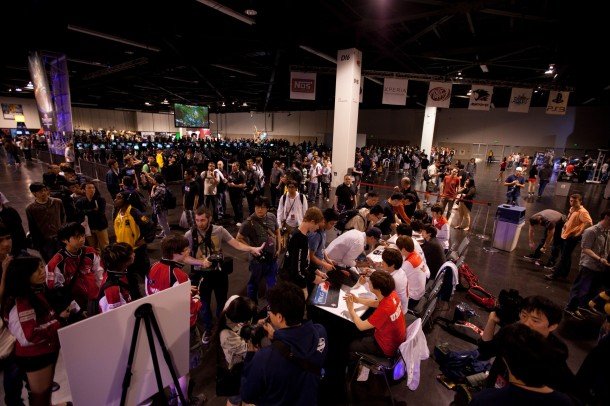Flash of greatness: StarCraft pro-gaming explored

As Brood War perpetuated, StarCraft II built its own scene, and germinated its own stars. Some came from the older game, B-teamers or young players who saw their future in the sequel; others rose fresh, straight from schools and colleges and into the growing global e-sports limelight. Throughout the weekend, they mill around the Anaheim Convention Center, easy to spot with the trained eye. There's Jang Min Chul – MC by nickname – cocky, slightly tubby, walking purposefully with arms wide. Lee Dong Nyung stands among groups of his friends looking vaguely nervy, the winner of a previous MLG Championship at only 16. They're heroes to the 20,000 people present in the cavernous room. As the Spring Championships rage around them, they're signing autographs, taking pictures, and having gangs of wide-eyed fans ushered away from them so they can play their allocated games. They hop between PCs, whirling centres of jetlagged motion with gruelling match schedules, getting knocked out or progressing through the ranks to the overall final on the Sunday afternoon. They're there for business, to win an oversized cheque that'll let them keep their team in communal food and brand new uniforms for another few months.
But when Flash steps out from the backstage curtain, past the black, metal barrier that stops fans – kids and grown men – from pressing too close to the soundproof playing booth, they all stop. Kang Dong Hyun – Symbol, famed for beating an entire team including two Global StarCraft II League champions – sits behind me. His eyes are glassy as he wriggles in his seat, trying to catch a glimpse of the KeSPA players.

Flash is one of the last out on stage. His friends from the hotel are his rivals: Korean StarCraft players who've made a career out of playing 1998's Brood War expansion pack. At home, they're all as close to household names as e-sports has yet produced. Each has a second nickname on top of their chosen one, gifted by fans and divined from their play-style. Out in the confines of the real world, these names are oddly incongruous, but in front of a monitor, they make sense. Kim Yoon Hwan's player id is Calm; here, he looks anything but.
Announcer Clutch suggests that the braying crowd may know him as the 'Brain Zerg', able to coldly calculate several moves ahead of his foe. Kim Taek Yong is Bisu, or 'the Revolutionist', known for his unique tactics in Protoss versus Zerg matches that later filtered out to wider use. Lee Jae Dong is called Jaedong in his team, and 'the Tyrant' to his foes, a name earned from the Zerg player's ruthless style. Jung Myung Hoon – Fantasy – is known as the 'Crown Prince'.
Korean crowds, legend goes, are milder and meeker than their Western counterparts. Tournaments in the East are held at exotic locations – waterparks, beaches, and theme parks – but the fans are quieter in their appreciation. In Anaheim, a camera on a giant boom swings out across the crowd. People leap out of their seats, flailing their arms and screaming in an attempt to be noticed. One aims an exuberant punch at the device as it dangles perilously low. During Korean tournaments, fans cover their face if lit up on the roving camera's big screen; here, the subject invariably starts dancing.

It's a cultural difference that's not lost on the players on stage. After the tournament, all eight are asked what the biggest difference is between Korean and Western StarCraft. All answer the same: the crowd. They're louder, more passionate, more willing to wear their emotions on their sleeves. Later in the weekend, at a closing party in a repurposed ballroom back at my hotel, I see two male fans take things to the next level, stripping off their shirts and cavorting around in a near-naked gambit to win a spot in a 2v2 StarCraft II match alongside pro-gamers.
Back at MLG, the noise coming from the crowd increases with each player's entrance. Figures after the event show that 20,000 people packed Anaheim Convention Centre over the Championship weekend. From my seat, it feels like most of them are arranged behind me: seated, standing, sprawling on the floor. The first player on stage – Kim Seul Ki, Soulkey – shuffles out in front of the crowd, waving politely. He's called over to the microphone, and the cacophony quietens for a moment.
Keep up to date with the most important stories and the best deals, as picked by the PC Gamer team.
“Hello.”
The noise is redoubled. The KeSPA players quickly realise the power of their faltering English. Everything they say is greeted with a torrent of cheers. Fantasy is called up, his body jittery as he stalks the length of the sizeable stage. Grasping the mic, he calls the crowd to attention and exclaims, in breathy English, “I will dominate!”

